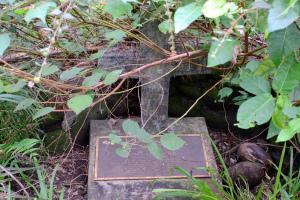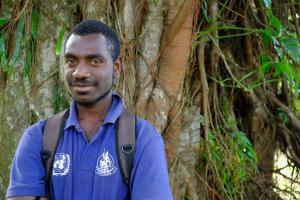 John G. Paton and his wife Mary, who would soon give birth to their first child, landed at Port Resolution in 1858. They were not the first missionaries to serve in the Port Resolution area of Tanna and they were certainly not the last.
John G. Paton and his wife Mary, who would soon give birth to their first child, landed at Port Resolution in 1858. They were not the first missionaries to serve in the Port Resolution area of Tanna and they were certainly not the last.
First came Lalolangi, Salamea and Mose, all Samoans who were placed there by John Williams in 1839. Pomare and Vaiofanga, more Samoans, added to their team in 1840. Salamea and Pomare died and the remaining three were joined by Dr George Turner and Henry Nisbet and their wives from Scotland in 1842. They were all driven off the island the following year.
Then came three Rarotongans and four more Samoans in 1845 who were again driven off after one was martyred in 1846. Two of them returned in 1847 and a third was added in 1848. All died of smallpox except one who had to escape after they were blamed for the disease and four female converts were murdered.
The next missionary was Abraham, a man from Aneityum, the newly-converted island south of Tanna, who arrived in 1845 and was later joined by others from the same island.
John and Mary Paton arrived from Scotland in October 1858 and built their house on a site which to this day is thick with mosquitoes. Mary gave birth to their son, Peter, on 12th February 1859, but died of malaria on 3rd March. Peter died 17 days later.
Paton buried his wife and son himself as well as Samuel Johnston who came to assist Paton and died of malaria in 1861 after a club wound to the head.
Johnston was clubbed when he and Paton were attacked as a result of a measles epidemic, which was deliberately planted by traders and blamed on the Christians. In the escalating violence, Christian converts were once again martyred as chiefs who were once sympathetic abandoned them.
Kowia, a Tannese chief who was converted on Aneityum prayed a dying prayer with Paton as Paton himself lay close to unconsciousness with what was at least his fifteenth bout of malaria. Kowia prayed:
‘O Lord Jesus, Missi Johnston is dead, his wife is ill, Missi Paton is ill, I am sick, and Thy servants the Aneityumese are all sick and dying. O Lord, You cannot forsake Tanna, and leave our people to die in darkness!’
Paton soon buried Kowia alongside his Aneityumese wife and children who had already died in the mission effort.
Namuri, another Aneityumese missionary, was clubbed and died praying:
‘O Lord Jesus, forgive them for they know not what they are doing. Do not take away your worship from this dark island! O God, bring all the Tannese to love and follow Jesus!’
He was just one of many who died in 1861 so that the people of Tanna and particularly the Port Resolution area might know Jesus.
Paton escaped overland to the Matheson’s mission station in South Tanna along with Abraham. Abraham had been the first Aneityumese missionary to arrive, and was the last to leave. They were pursued right to the Matheson’s station where they were attacked and the church was burned. They all escaped on a trading ship, sick and very weak. Both the Matheson’s died within six months and Paton survived to one day return to evangelise the nearby island, Aniwa.
By the time that Paton escaped in 1861, more than 25 missionaries had served in the Port Resolution mission field. Many of them and their converts had died of disease or had been martyred. All the rest had been driven off the island. None remained.
In God’s grace and mercy the gospel was eventually established at Port Resolution when Thomas and Lucy Neilson landed in 1868 along with more Aneityumese, and the church was established across on Tanna through the work of many others including Frank Paton (son of John and his second wife, Margaret).
However by the end of the 1930’s people began to turn away from the church in favour of new movements arising from the world-view held within their traditional animism. The strongest of these would become the John Frum Cargo Cult, with its center just around the headland from Port Resolution at Sulphur Bay.
It wasn’t until 2001 that Port Resolution was re-opened as a Christian mission field.
Last year Luke Scott, a descendant of John Paton’s brother, James, contacted me to help him fulfill his childhood dream of visiting the graves of Mary and Peter Paton at Port Resolution.
Visiting the graves is an emotional experience for a young male missionary. Without ever desiring death, I am sure that most of us would prefer to have our own lives taken than bear the burden of burying the wife whom we brought and the first child whom she bore. Today, the shared grave is adorned by a plaque with Paton’s own words taken from his autobiography:
‘Whensoever Tanna turns to the Lord, and is won for Christ, men in after-days will find the memory of that spot still green, – where with ceaseless prayers and tears I claimed that land for God in which I had “buried my dead” with faith and hope.’
I lamented the fact that after 175 years of mission at Port Resolution, we had only a struggling work planted there. Luke had different interpretation. He wanted to encourage me, pointing out that the tears have already fallen and the prayers had been offered for so long; it is time, he thought, for the harvest.
Perhaps he was right.

Last month I visited Naprantata and was thrilled to see the work growing in that area. They had appointed a mission coordinator who had first mapped their area and then identified potential areas for outreach. They had placed workers at previously vacant mission fields (one of whom is pictured) and established six new works.
It is likely that not all of these works will succeed and to this day the work of Port Resolution is still struggling, but in God’s grace some of this diligent work may bear fruit.
Please be in prayer for the people doing outreach in Naprantata and for the people of that area. Pray with Kowia that God will not leave these people in darkness, with Namuri that in fact they will come to love and follow Jesus, and so with Paton, in faith and hope, that the island will be won for Christ.
(Sources: Miller, J. Graham, Live: A History of Church Planting in the New Hebrides, vols. 1 & 2; Paton, John G., Missionary to the New Hebrides: An Autobiography.)
From our pray letter. Full letter here: http://talkingabouttanna.com/prayer-letters/
